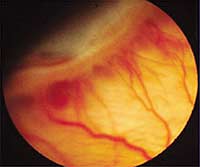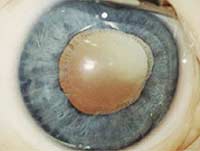15-year screening for ROP shows increasing incidence but better outcomes
Only a small percentage of premature infants develop severe ROP and the risk of blindness has been greatly reduced.
MONTREUX, Switzerland – Screening for retinopathy of prematurity over a 15-year period carried out in five neonatal units in Germany showed that in spite of the increasing number of premature infants, the number of blind infants has decreased significantly.
“ROP is one of the leading causes of childhood blindness in the western world. However, since the first description of the disease in 1942, long period studies on ROP incidence are rare,” said Volker Seiberth, MD, speaking at the Club Jules Gonin meeting here. Dr. Seiberth is head of the Osnabrück Eye Clinic in Osnabrück, Germany.
 |  |
Severe ROP from stages 3 to 5 was seen in 16% of infants with birth weight of 1,500 g or less. | |
“Our screening was performed prospectively by six examiners collecting data from 1986 to 2000. A total of 4,449 surviving premature infants were examined in the five clinics involved in the study,” Dr. Seiberth said.
ROP rates
Out of the total number of 4,449 premature infants, 2,390 were very low birth-weight infants, weighing between 360 g to 1500 g. Gestational age was from 23 to 36 weeks. Eight hundred and eighty-four premature infants showed birth weight of 1,000 g or less.
“In 47% of the 2,390 infants with birth weight of 1,500 g or less, ROP of all stages developed. Obviously, the incidence of ROP tended to increase with lower birth weight: 77% in the group of 884 infants with birth weight of 1,000 g or less, 88% in the 297 infants with birth weight of 750 g or less and 87% in the 31 infants with birth weight of 500 g or less,” Dr. Seiberth said.
“However, it should be considered that more than 10% of these extremely premature infants did not develop any stage of ROP,” he added.
Severe ROP from stages 3 to 5 was seen in 16% of infants with birth weight of 1,500 g or less.
Risk factors for retinopathy of prematurityROP appears to be a multifactorial disease, with many different conditions or stimuli contributing to the risk of developing this problem. There are several known or suspected risk factors for the development of retinopathy of prematurity, including:
The incidence of ROP appears to be independent of whether the patient is male or female, and there is no difference in the incidence of ROP for the right eye versus the left eye. It also does not appear to matter whether the infant is a product of a single or multiple birth. |
Encouraging outcomes
Dr. Seiberth reported that in 96% of the cases acute ROP regressed spontaneously. In the remaining 4% treatment was carried out by using cryotherapy or, since 1992, diode laser. In spite of the treatment, seven infants (0.3%) ended up with stage 5 ROP in one eye and 10 infants (0.5%) became blind with stage 5 ROP in both eyes.
“Looking at 5-year sections of the 15-year period, a tendency toward more premature infants with lower birth weight and lower gestational age is obvious. Though the overall rate of severe ROP increased consequently from 10% to 22% over the screening period, the number of blind infants decreased significantly from 1.2% to 0.4%,” Dr. Seiberth said.
Retinopathy of prematurity is an enduring problem in economically developing parts of the world because of the ever-increasing survival rate of low and very low birth-weight infants, he said.
“However, we have developed high standards of neonatal care, new screening criteria, new technologies and treatment methods that have enabled us to cut down on the rate of severe visual impairment connected with this disorder,” he said.
For Your Information:
- Volker Seiberth, MD, can be reached at Marienhospital Osnabrück, Johannisfreiheit 2-4, 49074 Osnabrück, Germany; (49) 541-326-4401; fax: (49) 541-326-4412; e-mail: dr.seiberth@t-online.de.
